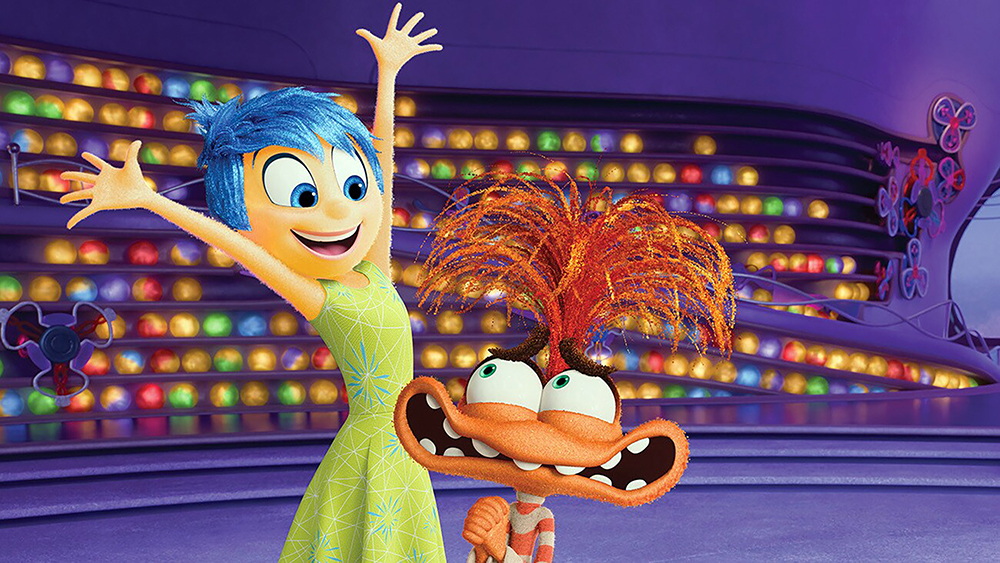As we walked out of Inside Out 2, my wife turned to me and said, “They really nailed anxiety!”
The first Inside Out, directed by Pete Docter in 2015, is one of the crown jewels of American animation. It’s also one of the few films for kids (or anyone, really) that is explicitly about mental health. The premise, which it shares with the now-forgotten ’80s sitcom Herman’s Head, is that inside everyone is a committee of personified emotions whose deliberations and disputes determine behavior. Riley, voiced by Kaitlyn Dias, is an 11-year-old girl from Minnesota whose world is upended when her family moves to San Francisco. On the outside, she tries to put on a brave face. But on the inside, her young emotions are in turmoil. Joy (Amy Poehler) is the leader of the emotions, but when she and Sadness (Phyllis Smith) are thrown from Riley’s cerebral control room, Anger (Lewis Black), Fear (Bill Hader) and Disgust (Mindy Kaling) take over, and Riley tries to run away from home and return to Minnesota. Only when Joy and Sadness fight their way back to the control room, thus restoring emotional balance, can Riley come to terms with her new life.
Inside Out 2 picks up a couple of years later. Riley (now voiced by Kensington Tallman) is 13 years old, and despite her fears that no one plays hockey in San Francisco, she’s on a team with her two besties Grace (Grace Lu) and Bree (Sumayyah Nuriddin-Green). Next year, they’ll be headed for high school, where they want to skate for the Firehawks, the varsity hockey team led by star player Val (Lilimar). After a big win, the friends get invited to a summer skills camp run by the Firehawks’ hardass Coach Roberts (Yvette Nicole Brown). It’s Riley’s chance to prove she’s good enough to make the team, and she’s initially excited.
But the night before the camp starts, things start to spin out of control in her emotional world. The Puberty Alarm starts flashing on Riley’s control panel, and Minion-like Mind Workers bust in to start demolishing the place. “Pardon our dust! Puberty is messy!”
The workers are expanding to make space for a new set of emotions, courtesy of puberty: Envy (Ayo Edebiri), Embarrassment (Paul Walter Hauser), Ennui (Adèle Exarchopoulos), Nostalgia (June Squibb), and Anxiety (Maya Hawke). Also, Riley has acne now, just in time to meet the gaggle of older girls who rule the Firehawks roost.
After years of maintaining emotional equilibrium and cultivating a strong sense of self for Riley with only five emotions, Joy is thrown for loop when she tries to manage the newcomers. Anxiety is especially troublesome. After an early blunder by Joy leads to Riley getting yelled at by the coach, Anxiety takes over. Joy only reacts, but Anxiety is a planner, which seems like a prudent thing as Riley tries to navigate a fraught new social situation. Plus, Joy has been maintaining the status quo by putting all of Riley’s negative memories way in the back of the mind, where they are conveniently out of sight, but never dealt with. The fact that processing these bad memories will strengthen Riley’s sense of self never occurs to Joy, who only focuses on the positive. Soon, Anxiety banishes Joy’s hard-won sense of self to the same oblivion as Riley’s suppressed memories, and our young hero starts alienating her friends and trying on a new, fake identity she thinks will get her an in with the popular girls, and a spot on the team.
Anxiety is the breakout star of Inside Out 2, for good reason. We are living in an age of anxiety, brought on by the deteriorating climate, the specter of Trumpian fascism, pandemic malaise, addictive social media algos, and wars simmering in the background. Is it any wonder the kids are nervous all the time?
Kelsey Mann, who took over when Pete Docter was promoted to Pixar’s chief creative officer, puts his focus on Anxiety, and how it works to monopolize the imagination and blind you to the complexities of reality, all in a brisk 98 minutes. When Riley has a panic attack during the big game, the experience is downright harrowing for anyone who has been there themselves. Riley ultimately makes it through it all with a sense of self that is stronger because it is more complex. The kids (and the adults) who pay attention to the message behind the visual fireworks will come away with an easily understood example of how to process the confusing emotions of teen-dom. I wish I had Inside Out when I was young.
Inside Out 2
Now playing
Multiple locations
